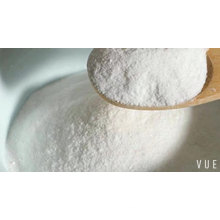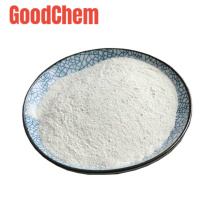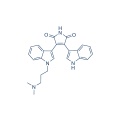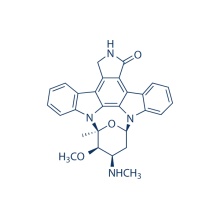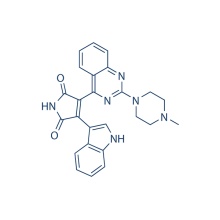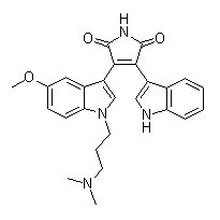.cp_wz tabla {borde superior: 1px sólido #ccc; borde izquierdo: 1px sólido #ccc; } .cp_wz table td {borde derecho: 1px sólido #ccc; borde inferior: 1px sólido #ccc; padding: 5px 0px 0px 5px;} .cp_wz table th {border-right: 1px solid #ccc; border-bottom: 1px solid #ccc; relleno: 5px 0px 0px 5px;} \ n Peso molecular: \ n 412.48 GF109203X es un potente inhibidor de PKC con IC50 de 20 nM, 17 nM, 16 nM y 20 nM para PKCα, PKCβI, PKCβII y PKCγ, respectivamente, mostrando selectividad de más de 3000 veces para PKC en comparación con EGFR, PDGFR y receptor de insulina. \ n Actividad biológica
|
Description
|
GF109203X is a potent PKC inhibitor with IC50 of 20 nM, 17 nM, 16 nM, and 20 nM for PKCα, PKCβI, PKCβII, and PKCγ, respectively, showing more than 3000-fold selectivity for PKC as compared to EGFR, PDGFR and insulin receptor.
|
|
Targets
|
PKCβ2 [1]
|
PKCβ1 [1]
|
PKCα [1]
|
PKCγ [1]
|
PDGFR [1]
|
   View More
|
|
IC50
|
16 nM
|
17 nM
|
20 nM
|
20 nM
|
65 μM
|
|
In vitro
|
GF109203X, as an ATP-competitive PKC inhibitor, prevents platelet aggregation induced by stimuli that activate PKC, and has the potential as a tool for studying the involvement of PKC in signal transduction pathways. GF 109203X produces reversal activity on P-glycoprotein and MRP -mediated multidrug resistance. PKC inhibition by GF109203X significantly reduces carbachol-stimulated ERK1/2 activation and the subsequent proliferation of SNU-407 colon cancer cells.
|
|
In vivo
|
|
|
Features
|
Greater selectivity than PKC inhibitor staurosporine. GF109203X is a chemical probe for studying PKC signal transduction pathways. Potential for use in a variety of cancers.
|
Protocolo (solo como referencia) Ensayo de quinasa: [1]
|
Assay of protein kinase C
|
Protein kinase C is arrayed by measuring 32PI transferred from [gamma-32PI] ATP to lysine-rich histone type Ill-s. The reaction mixture (80 μL) contained 50 mM Tris-HCI. pH 7.4, 100 μM CaCl2, 10 mM MgCI2, 37.5 μL/mL histone type Ill-s, 10 μM [gamma-32PI] ATP (1250 cpm/pmol), 31 μM bovine brain phosphatidylserine and 0.5 μM 1,2 sn-dioleylglycerol. Fifteen μL of purified PKC (final concentration in assay 0.38 μg/mL) is added to the incubation mixture. After 10 min at 30°C, the reaction is stopped by addition of 30 μL of casein 30 mg/mL and 0.9 ml of 12% trichloroacetic acid. The acid precipitable material is collected by centrifugation, dissolved in 1N NaOH (100μL) and precipitated again with 1 ml of 12% trichloroacetic acid. The pellet is dissolved in 1N NaOH (100μL) and 32P incorporation is measured by scintillation counting in Aquasol.
|
Ensayo celular: [4]
|
Cell lines
|
SNU-407 colon cancer cells
|
|
Concentrations
|
1 μM
|
|
Incubation Time
|
48 hours
|
|
Method
|
Cell proliferation is monitored by the 3-(4,5-dimethylthiazol-2-yl)-2,5-diphenyl tetrazolium bromide (MTT) assay. Cells are seeded in 96-well plates and allowed to grow overnight. The cells are serum-starved for 18–24 hours and then treated with 1 mM carbachol for 48 hours in 100 μL serum-free RPMI 1640. Inhibitors are added 30 min prior to carbachol treatment. Following the treatment, 10 μL of MTT solution (5 mg/ml) is applied to each well, and the plates were incubated for 3 h at 37 °C. After the medium is removed, the formazan crystals formed are solubilized in 100 μL DMSO. The absorbance at 570 nm is measured using a microplate reader and the background absorbance at 690 nm is subtracted. Each assay is performed in triplicate.
|
Conversión de diferentes modelos de animales basados en BSA (valor basado en datos del Borrador de Directrices de la FDA)
|
Species
|
Baboon
|
Dog
|
Monkey
|
Rabbit
|
Guinea pig
|
Rat
|
Hamster
|
Mouse
|
|
Weight (kg)
|
12
|
10
|
3
|
1.8
|
0.4
|
0.15
|
0.08
|
0.02
|
|
Body Surface Area (m2)
|
0.6
|
0.5
|
0.24
|
0.15
|
0.05
|
0.025
|
0.02
|
0.007
|
|
Km factor
|
20
|
20
|
12
|
12
|
8
|
6
|
5
|
3
|
|
Animal A (mg/kg) = Animal B (mg/kg) multiplied by
|
Animal B Km
|
|
Animal A Km
|
Por ejemplo, para modificar la dosis de resveratrol utilizada para un ratón (22,4 mg / kg) a una dosis basada en el BSA para una rata, multiplique 22,4 mg / kg por el factor Km para un ratón y luego divida por el factor Km para una rata. Este cálculo da como resultado una dosis equivalente para ratas de resveratrol de 11,2 mg / kg.
|
Rat dose (mg/kg) = mouse dose (22.4 mg/kg) ×
|
mouse Km(3)
|
= 11.2 mg/kg
|
|
rat Km(6)
|
Información química
|
Molecular Weight (MW)
|
412.48
|
|
Formula
|
C25H24N4O2
|
|
CAS No.
|
133052-90-1
|
|
Storage
|
3 years -20℃Powder
|
|
6 months-80℃in solvent (DMSO, water, etc.)
|
|
Synonyms
|
GO 6850 , Bisindolylmaleimide I
|
|
Solubility (25°C) *
|
In vitro
|
DMSO
|
82 mg/mL
(198.79 mM)
|
|
Water
|
<1 mg/mL
(
|
|
Ethanol
|
<1 mg/mL
(
|
* <1 mg/ml means slightly soluble or insoluble.
* Please note that Selleck tests the solubility of all compounds in-house, and the actual solubility may differ slightly from published values. This is normal and is due to slight batch-to-batch variations.
|
|
Chemical Name
|
1H-Pyrrole-2,5-dione, 3-[1-[3-(dimethylamino)propyl]-1H-indol-3-yl]-4-(1H-indol-3-yl)-
|
Calculadora de molaridad Calculadora de dilución Calculadora de peso molecular Área de investigación Citas de productos (2) Papel de los receptores de glutamato metabotrópicos del grupo I, mGluR1 / mGluR5, en la fosforilación de la conexina43 y la inhibición de la comunicación intercelular de unión gap en células de cardiomioblastos H9c2. [Xie F, et al. Mol Cell Biochem 2014; 10.1007 / s11010-014-2278-x] PubMed: 25421413 La migración e invasión de las células del carcinoma escamoso oral es promovida por WNT5A, un regulador de la progresión del cáncer. [Prgomet Z, et al. J Oral Pathol Med 2014; 10.1111 / jop.12292] PubMed: 25459554 Clientes que compraron este artículo también compraron H 89 2HCl H 89 2HCl es un potente inhibidor de PKA con Ki de 48 nM, 10 veces más selectivo para PKA que para PKG, mayor que Selectividad 500 veces mayor que PKC, MLCK, calmodulina quinasa II y caseína quinasa I / II. CHIR-99021 (CT99021) HCl CHIR-99021 (CT99021) HCl es clorhidrato de CHIR-99021, que es un inhibidor de GSK-3α / β con IC50 de 10 nM / 6,7 nM; capacidad para distinguir entre GSK-3 y sus homólogos más cercanos Cdc2 y ERK2. SB203580 SB203580 es un inhibidor de p38 MAPK con IC50 de 0,3-0,5 μM, 10 veces menos sensible a SAPK3 (106T) y SAPK4 (106T) y bloquea la fosforilación de PKB con IC50 de 3-5 μM. Características: Primer inhibidor de p38 reportado. Vemurafenib (PLX4032, RG7204) Vemurafenib (PLX4032, RG7204) es un inhibidor nuevo y potente de B-RafV600E con IC50 de 31 nM. Características: Un inhibidor novedoso y potente de la oncoproteína B-RAFV600E. Afatinib (BIBW2992) Afatinib (BIBW2992) inhibe irreversiblemente EGFR / HER2, incluidos EGFR (wt), EGFR (L858R), EGFR (L858R / T790M) y HER2 con IC50 de 0,5 nM, 0,4 nM, 10 nM y 14 nM, respectivamente; 100 veces más activo contra el mutante EGFR L858R-T790M resistente a gefitinib. CX-4945 (Silmitasertib) CX-4945 (Silmitasertib) es un inhibidor potente y selectivo de CK2 (caseína quinasa 2) con IC50 de 1 nM, menos potente para Flt3, Pim1 y CDK1 (inactivo en un ensayo basado en células). Fase 1/2. Características: Primer inhibidor clínico de CK2. Soporte técnico y preguntas frecuentes Las respuestas a las preguntas que pueda tener se pueden encontrar en las instrucciones de manejo del inhibidor. Los temas incluyen cómo preparar soluciones madre, cómo almacenar inhibidores y cuestiones que requieren atención especial para ensayos basados en células y experimentos con animales.
Grupos de Producto : Señalización citoesquelética > Inhibidor de PKC


